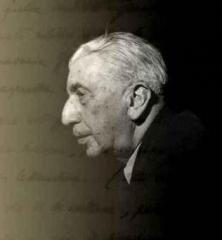Roberto Longhi facts for kids
Quick facts for kids
Roberto Longhi
|
|
|---|---|

Longhi in around 1960
|
|
| Born | 28 December 1890 |
| Died | 3 June 1970 (aged 79) |
| Citizenship | Italian |
| Alma mater | University of Turin |
| Known for | Scholarship on Caravaggio and Piero della Francesca. |
| Spouse(s) | Lucia Lopresti (1895-1985) |
| Scientific career | |
| Fields | art history |
| Patrons | Count Alessandro Contini Bonacossi (1878-1955) |
| Thesis | (1911) |
| Doctoral advisor | Pietro Toesca |
| Notable students | Giovanni Previtali, Luciano Bellosi |
Roberto Longhi was a famous Italian art historian and expert. He was born on December 28, 1890, and passed away on June 3, 1970. He spent a lot of time studying the works of two important painters: Caravaggio and Piero della Francesca.
Contents
Early Life and Studies
Roberto Longhi was born in December 1890 in a town called Alba. His parents came from the Emilia region of Italy. He studied art history with two important teachers: Pietro Toesca in Turin and Adolfo Venturi in Rome.
In 1914, Adolfo Venturi made Longhi the book reviews editor for an art magazine called L'Arte. Between 1913 and 1917, Longhi wrote many essays for L'Arte and another magazine, La Voce. He wrote about artists like Mattia Preti, Piero della Francesca, and Orazio Gentileschi.
Discovering Masterpieces
Between 1920 and 1922, Longhi went on a "Grand Tour" of Europe. This meant he traveled to see many famous artworks in person. He saw paintings in places like the Borghese Gallery in Rome. His travels helped him find many lost masterpieces. For example, he rediscovered two parts of an altarpiece painted by the famous artist Giotto.
Studying Caravaggio
Throughout his career, Longhi became very interested in the painter Caravaggio and his followers. Caravaggio was known for his dramatic use of light and shadow in paintings.
Longhi wrote several books about Caravaggio. One important book was Quesiti caravaggeschi (Questions on Caravaggio), published between 1928 and 1934. He followed this with Ultimi studi caravaggeschi (Latest Caravaggio studies) in 1943.
In 1951, Longhi organized a very important art show about Caravaggio. It was held in Milan at the Royal Palace and was called Mostra di Caravaggio e dei Caravaggeschi. This exhibition helped many people learn more about Caravaggio's art. In 1968, Longhi wrote a detailed book about the artist.
Focus on Piero della Francesca
Even though he was a leading expert on Caravaggio, Longhi also loved the work of Piero della Francesca. In 1928, he wrote a book about Piero della Francesca. In this book, Longhi said that Piero della Francesca was the most important painter of the 1400s, a period called the Quattrocento.
Longhi believed that Piero della Francesca played a big role in how painting developed in Venice. Another famous art historian, Kenneth Clark, said that Longhi's book on Piero della Francesca was so good it could hardly be made better. This book became a classic in art history.
Other Interests and Work
Longhi also helped bring attention back to many artists who followed Caravaggio. One of these was Hendrick ter Brugghen, and Longhi wrote a book about him in 1927. He also studied painters from Ferrara. His book Officina Ferrarese (1934) is still considered an excellent study of these artists.
After publishing Officina Ferrarese, Longhi started teaching at universities. He became a professor at Bologna University in 1935, and later taught in Florence.
In 1950, Longhi helped start an art and literature magazine called Paragone. He also edited the magazine with Anna Banti. Paragone is still published today.
Longhi organized several other art exhibitions. These included shows about Bolognese painting in 1948, Lombard painters in 1953, and Lombard art from the Visconti to the Sforza families in 1958.
Roberto Longhi passed away on June 3, 1970. He is buried in the Cimitero degli Allori cemetery in Florence.
See also
 In Spanish: Roberto Longhi para niños
In Spanish: Roberto Longhi para niños


